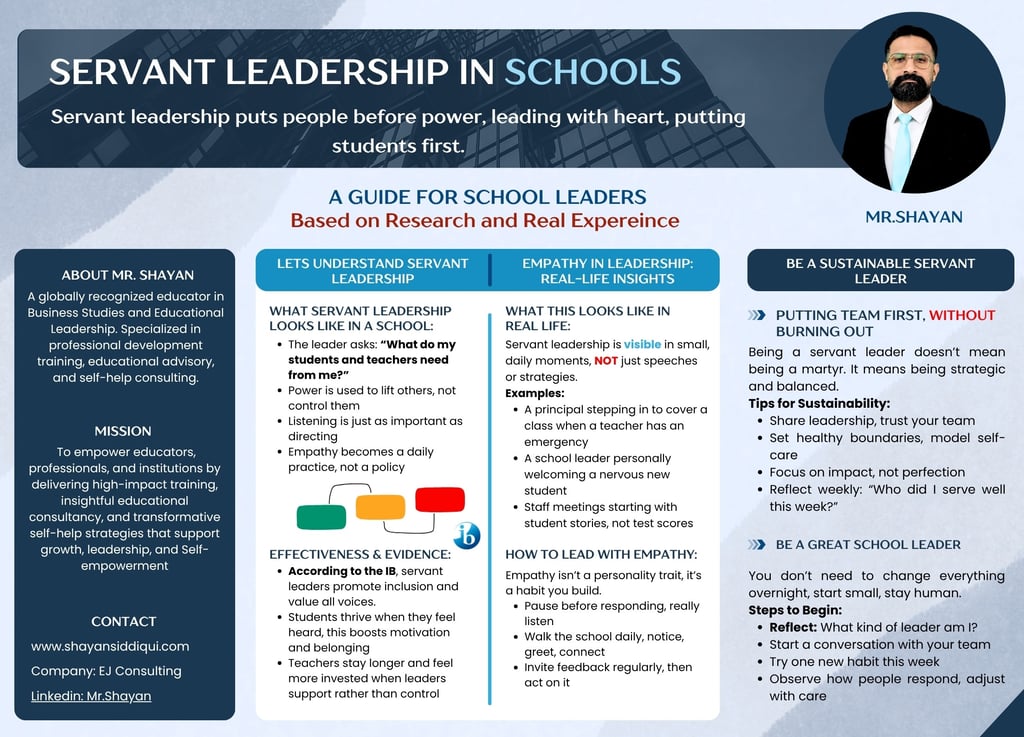
Servant Leadership In Schools
In my executive coaching sessions with school heads, one theme consistently emerges: the most impactful leaders are those who serve before they direct. This article explores how servant leadership transforms school culture, strengthens trust, and empowers teams offering practical insights for educational leaders seeking to lead with empathy, vision, and lasting influence.
Mr. Shayan Siddiqui
8/6/20253 min read


Servant Leadership in Schools.
Walk into any thriving international school and you’ll notice something subtle but powerful: leadership that listens. Leadership that serves. Leadership that puts people first, not positions. This isn’t accidental it’s the heartbeat of servant leadership, a model that’s transforming how visionary school heads, principals, and coordinators are reshaping education from the inside out.
In a world where educational leadership often gets tangled in rankings, reputation, and rigid systems, servant leadership offers a countercultural but deeply effective approach. It’s not about having authority. It’s about using authority to uplift others.
What Is Servant Leadership Really?
The term was coined by Robert Greenleaf in 1970, but the concept is ancient. At its core, servant leadership means this: you lead by serving. Your primary motivation is to meet the needs of your team, your students, your families and in doing so, build an institution grounded in trust, empathy, and long-term growth.
In schools, this means:
Putting the emotional well-being of students above inspection checklists
Valuing the voices of teachers before issuing top-down mandates
Asking: “What do you need to thrive?” before asking: “Why haven’t you delivered?”
This isn’t soft leadership. It’s strategic humility. And it’s becoming essential in international school contexts where diversity, complexity, and pressure coexist.
Why Schools Need Servant Leadership More Than Ever
International schools operate in a complex ecosystem: multicultural communities, high parent expectations, transient staff, and rapidly changing educational paradigms. In such settings, leadership cannot be transactional it must be deeply relational.
Here’s why servant leadership is urgently needed in schools:
Teacher morale is fragile: Servant leaders restore it by showing genuine care and trust.
Students face hidden pressures: Servant leaders see the whole child, not just the grade.
Parents want partnership, not performance reports: Servant leaders listen, not lecture.
Teams perform best when they feel safe: Servant leaders create that safety.
John C. Maxwell once wrote, “People don’t care how much you know until they know how much you care.” In schools, this truth is magnified tenfold.
Servant Leadership vs. Traditional School Leadership
Traditional Leadership Servant Leadership Top-down decisions Collaborative decision-making Focus on control Focus on trust and empowerment Staff as implementers Staff as co-creators Metrics before meaning Meaning before metrics “My door is open” “I’ll come to your door”
While both models aim for success, servant leadership achieves it with people, not over people.
What Servant Leadership Looks Like in Action
So, what does this actually look like in a real school?
Here are some indicators you're seeing a servant leader in action:
They ask questions more than they issue orders.
They attend a teacher’s class to support, not evaluate.
They listen in parent meetings to understand, not to defend.
They are visible not only in assemblies, but in the cafeteria, the playground, the corridors.
They share the credit and own the blame.
This kind of leadership builds loyalty, safety, and a shared sense of purpose. It changes not just how people perform, but how they feel about the place they work in.
How to Build a Servant Leadership Culture in Your School
This doesn’t happen overnight. Building a culture of servant leadership requires intention and inner work. Here’s where to start:
Start with Self-Awareness
Ask: Am I more focused on results or relationships?
Your inner motives shape your external actions.Prioritize Listening Systems
Not just suggestion boxes real, structured listening: teacher feedback sessions, student voice forums, anonymous surveys.Celebrate Others First
Make recognition part of your leadership rhythm and not just at end-of-year parties.Model Vulnerability
Admit when you don’t know. Ask for help. Share your learning process with your team.Develop Leadership at Every Level
A servant leader doesn’t create followers. They create more leaders.
A Real-World Example
One international school in the Middle East faced high staff turnover, growing parent complaints, and low student engagement. Instead of doubling down on systems, the new head of school shifted the leadership culture. Weekly walk-ins turned into check-in circles. Top-down staff meetings became shared design sessions. The result? Within a year, teacher retention increased by 40%, and parental trust scores improved dramatically.
The secret wasn’t more policy. It was more presence.
Final Reflection: The Inner Shift That Changes Everything
Servant leadership isn’t about being “nice” or doing extra work. It’s about changing your lens: from leading to be followed to leading so others can flourish.
If you're a school leader seeking long-term transformation, this is the question to ask:
Am I here to manage people or to serve their growth?
Your answer will shape your legacy.
FAQs about Servant Leadership in Schools
Q: Is servant leadership effective in high-performing academic environments?
A: Yes. Servant leadership doesn’t compromise standards it strengthens performance by improving team ownership, moservantrale, and purpose.
Q: What are the challenges of practicing servant leadership in schools?
A: It requires time, trust, and patience. Leaders must unlearn control-driven habits and invest in relational capital.
Q: Can servant leadership be developed or is it a personality trait?
A: It can absolutely be developed. It starts with mindset and grows through intentional leadership coaching and reflection.
Connect with me for the change
If you're ready to shift from pressure-driven leadership to purpose-driven leadership, I’d be honored to support that transformation. Let's explore how you can build a school culture where everyone feels seen, supported, and inspired to grow.